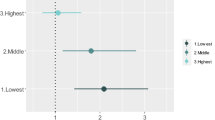Abstract
Purpose
To evaluate the associations between the presence of a grand parent at home that is three-generation household, with children mental health in diverse countries whether this situation is frequent or not.
Methods
Data from the School Children Mental Health in Europe cross-sectional survey in six countries (n = 4582) were used to examine the association between three-generation households and child mental health across Europe. The parent and teacher Strengths and Difficulties Questionnaire was combined to assess child mental clinical problems.
Results
Overall, 25.13% of European families live with at least one grandparent: 5.46% in Western and 29.70% in Eastern Europe. Controlling for key sociodemographic variables and for country of residence, the presence of a grandparent is associated with an increased risk for child mental health problems in the total sample (OR 1.37, p = 0.002). In two-parent homes, the effect of the presence of a grandparent is significant (OR 1.40, p = 0.026), while it is not in single-parent homes. In each country, the presence of a grandparent is a risk for either externalizing or internalizing problems.
Conclusions
Programs may be developed to educate elderly people to better respect their children’s role as parents so having a grandparent in the home can become an asset for family members rather than a burden.
Similar content being viewed by others
References
Dunifon R (2013) The influence of grandparents on the lives of children and adolescents. Child Dev Perspect 7(1):55–60. https://doi.org/10.1111/cdep.12016
Pilkauskas NV (2014) Living with a grandparent and parent in early childhood: associations with school readiness and differences by demographic characteristics. Dev Psychol 50(12):2587–2599
SHARE. Survey of Health, Ageing and Retirement in Europe. http://www.share-project.org/
Pittman LD, Boswell MK (2008) Low-income multigenerational households variation in family functioning by mothers’ age and race/ethnicity. J Fam Issues 29(7):851–881
Bengtson VL (2001) Beyond the nuclear family: the increasing importance of multigenerational bonds. J Marriage Fam 63(1):1–16
Dunifon RE, Ziol-Guest KM, Kopko K (2014) Grandparent coresidence and family well-being implications for research and policy. Ann Am Acad Polit Soc Sci 654(1):110–126
Courtin E, Avendano M (2016) Under one roof: The effect of co-residing with adult children on depression in later life. Soc Sci Med 168:140–149. https://doi.org/10.1016/j.socscimed.2016.09.020. (PubMed PMID: 27654932)
Simons LG, Chen Y-F, Simons RL, Brody G, Cutrona C (2006) Parenting practices and child adjustment in different types of households a study of african american families. J Fam Issues 27(6):803–825
Kellam SG, Ensminger ME, Turner RJ (1977) Family structure and the mental health of children: concurrent and longitudinal community-wide studies. Arch Gen Psychiatry 34(9):1012–1022
Kovess V, Carta MG, Pez O, Bitfoi A, Koç C, Goelitz D et al (2015) The School Children Mental Health in Europe (SCMHE) Project: design and first results. Clinical Practice and Epidemiology in Mental Health: CP & EMH 11(Suppl 1 M7):113–23. https://doi.org/10.2174/1745017901511010113. (PubMed PMID: PMC4378028)
Ware JE, Kosinski M, Dewey JE, Gandek B (2000) SF-36 health survey: manual and interpretation guide. Quality Metric Inc., Lincoln
Goodman R (1999) The extended version of the Strengths and Difficulties Questionnaire as a guide to child psychiatric caseness and consequent burden. J Child Psychol Psychiatry 40(05):791–799
Goodman R (2001) Psychometric properties of the strengths and difficulties questionnaire. J Am Acad Child Adolesc Psychiatry 40(11):1337–1345
Goodman R, Renfrew D, Mullick M (2000) Predicting type of psychiatric disorder from Strengths and Difficulties Questionnaire (SDQ) scores in child mental health clinics in London and Dhaka. Eur Child Adolesc Psychiatry 9(2):129–134
Bergeron L, Valla JP, Breton JJ (1992) Pilot study for the Quebec Child Mental Health Survey: part II. Correlates of DSM-III-R criteria among six to 14 year olds. Can J Psychiatry 37(6):381–386 (Epub 1992/08/01, PubMed PMID: 1394013)
Arnold DS, O’Leary SG, Wolff LS, Acker MM (1993) The Parenting Scale: a measure of dysfunctional parenting in discipline situations. Psychol Assess 5(2):137–144. https://doi.org/10.1037/1040-3590.5.2.137
Shleifer AT, Normal Countries D (2014) The east 25 years after communism. Foreign Aff 93:92
Audit Urban (2016) City Statistics (urb) National Institute of Statistics, Eurostat
Husky MM, Boyd A, Bitfoi A, Carta MG, Chan-Chee C, Goelitz D et al (2018) Self-reported mental health in children ages 6–12 years across eight European countries. Eur Child Adolesc Psychiatry 27(6):785–795. https://doi.org/10.1007/s00787-017-1073-0 (PubMed PMID: 29082450)
Kellam SG, Ensminger ME, Turner R (1977) Family structure and the mental health of children: concurrent and longitudinal community-wide studies. Arch Gen Psychiatry 34(9):1012–1022. https://doi.org/10.1001/archpsyc.1977.01770210026002
Deleire T, Kalil A (2002) Good things come in threes: single-parent multigenerational family structure and adolescent adjustment. Demography 39(2):393–413. https://doi.org/10.1353/dem.2002.0016
Jennifer March A, Raley RK (2012) Multigenerational households and the school readiness of children born to unmarried mothers. J Fam Issues 34(4):431–459. https://doi.org/10.1177/0192513X12439177
Acknowledgements
Funding was provided by Directorate-General for Health and Consumers (Grant no. 2006336).
Author information
Authors and Affiliations
Corresponding author
Ethics declarations
Conflict of interest
The authors declared to have no conflicts of interest.
Rights and permissions
About this article
Cite this article
Masfety, V.K., Aarnink, C., Otten, R. et al. Three-generation households and child mental health in European countries. Soc Psychiatry Psychiatr Epidemiol 54, 427–436 (2019). https://doi.org/10.1007/s00127-018-1640-9
Received:
Accepted:
Published:
Issue Date:
DOI: https://doi.org/10.1007/s00127-018-1640-9




